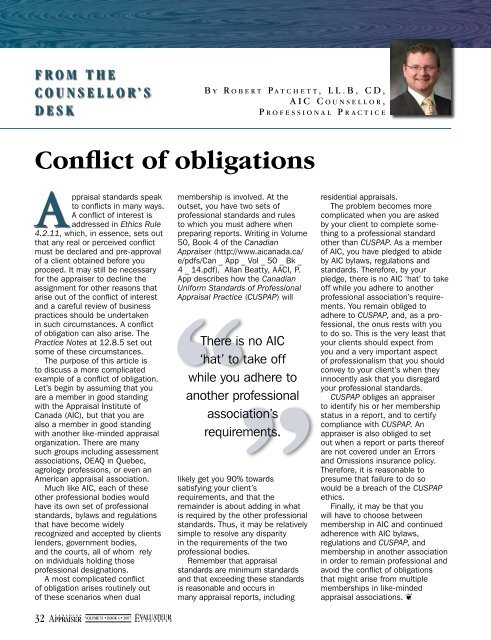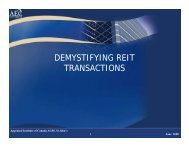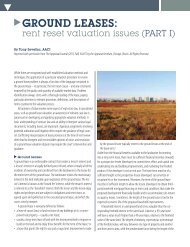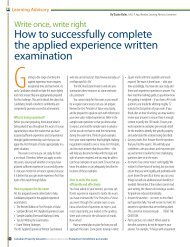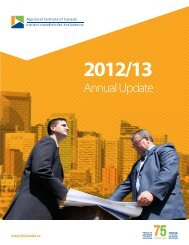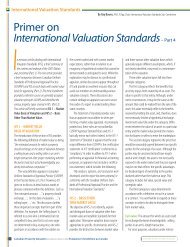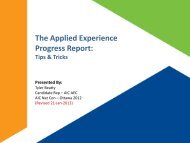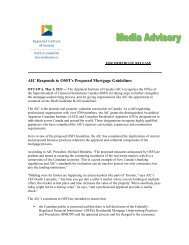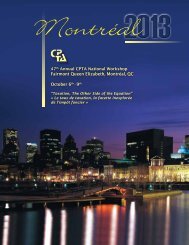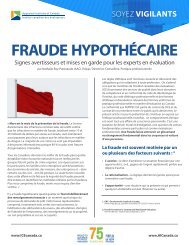Book 4 - Appraisal Institute of Canada
Book 4 - Appraisal Institute of Canada
Book 4 - Appraisal Institute of Canada
Create successful ePaper yourself
Turn your PDF publications into a flip-book with our unique Google optimized e-Paper software.
F r o m t h eC o u n s e l l o r ’ sD e s kB y R o b e r t P a t c h e t t , L L . B , C D ,A I C C o u n s e l l o r ,P r o f e s s i o n a l P r a c t i c eConflict <strong>of</strong> obligationsppraisal standards speakto conflicts in many ways.A conflict <strong>of</strong> interest isaddressed in Ethics Rule4.2.11, which, in essence, sets outthat any real or perceived conflictmust be declared and pre-approval<strong>of</strong> a client obtained before youproceed. It may still be necessaryfor the appraiser to decline theassignment for other reasons thatarise out <strong>of</strong> the conflict <strong>of</strong> interestand a careful review <strong>of</strong> businesspractices should be undertakenin such circumstances. A conflict<strong>of</strong> obligation can also arise. ThePractice Notes at 12.8.5 set outsome <strong>of</strong> these circumstances.The purpose <strong>of</strong> this article isto discuss a more complicatedexample <strong>of</strong> a conflict <strong>of</strong> obligation.Let’s begin by assuming that youare a member in good standingwith the <strong>Appraisal</strong> <strong>Institute</strong> <strong>of</strong><strong>Canada</strong> (AIC), but that you arealso a member in good standingwith another like-minded appraisalorganization. There are manysuch groups including assessmentassociations, OEAQ in Quebec,agrology pr<strong>of</strong>essions, or even anAmerican appraisal association.Much like AIC, each <strong>of</strong> theseother pr<strong>of</strong>essional bodies wouldhave its own set <strong>of</strong> pr<strong>of</strong>essionalstandards, bylaws and regulationsthat have become widelyrecognized and accepted by clientslenders, government bodies,and the courts, all <strong>of</strong> whom relyon individuals holding thosepr<strong>of</strong>essional designations.A most complicated conflict<strong>of</strong> obligation arises routinely out<strong>of</strong> these scenarios when dual32C a n a d i a nAppraiserVolume 51 • book 4 • 2007EvaluateurC a n a d i e nmembership is involved. At theoutset, you have two sets <strong>of</strong>pr<strong>of</strong>essional standards and rulesto which you must adhere whenpreparing reports. Writing in Volume50, <strong>Book</strong> 4 <strong>of</strong> the CanadianAppraiser (http://www.aicanada.ca/e/pdfs/Can _ App _ Vol _ 50 _ Bk _4 _ 14.pdf), Allan Beatty, AACI, P.App describes how the CanadianUniform Standards <strong>of</strong> Pr<strong>of</strong>essional<strong>Appraisal</strong> Practice (CUSPAP) willThere is no AIC‘hat’ to take <strong>of</strong>fwhile you adhere toanother pr<strong>of</strong>essionalassociation’srequirements.likely get you 90% towardssatisfying your client’srequirements, and that theremainder is about adding in whatis required by the other pr<strong>of</strong>essionalstandards. Thus, it may be relativelysimple to resolve any disparityin the requirements <strong>of</strong> the twopr<strong>of</strong>essional bodies.Remember that appraisalstandards are minimum standardsand that exceeding these standardsis reasonable and occurs inmany appraisal reports, includingresidential appraisals.The problem becomes morecomplicated when you are askedby your client to complete somethingto a pr<strong>of</strong>essional standardother than CUSPAP. As a member<strong>of</strong> AIC, you have pledged to abideby AIC bylaws, regulations andstandards. Therefore, by yourpledge, there is no AIC ‘hat’ to take<strong>of</strong>f while you adhere to anotherpr<strong>of</strong>essional association’s requirements.You remain obliged toadhere to CUSPAP, and, as a pr<strong>of</strong>essional,the onus rests with youto do so. This is the very least thatyour clients should expect fromyou and a very important aspect<strong>of</strong> pr<strong>of</strong>essionalism that you shouldconvey to your client’s when theyinnocently ask that you disregardyour pr<strong>of</strong>essional standards.CUSPAP obliges an appraiserto identify his or her membershipstatus in a report, and to certifycompliance with CUSPAP. Anappraiser is also obliged to setout when a report or parts there<strong>of</strong>are not covered under an Errorsand Omissions insurance policy.Therefore, it is reasonable topresume that failure to do sowould be a breach <strong>of</strong> the CUSPAPethics.Finally, it may be that youwill have to choose betweenmembership in AIC and continuedadherence with AIC bylaws,regulations and CUSPAP, andmembership in another associationin order to remain pr<strong>of</strong>essional andavoid the conflict <strong>of</strong> obligationsthat might arise from multiplememberships in like-mindedappraisal associations.


